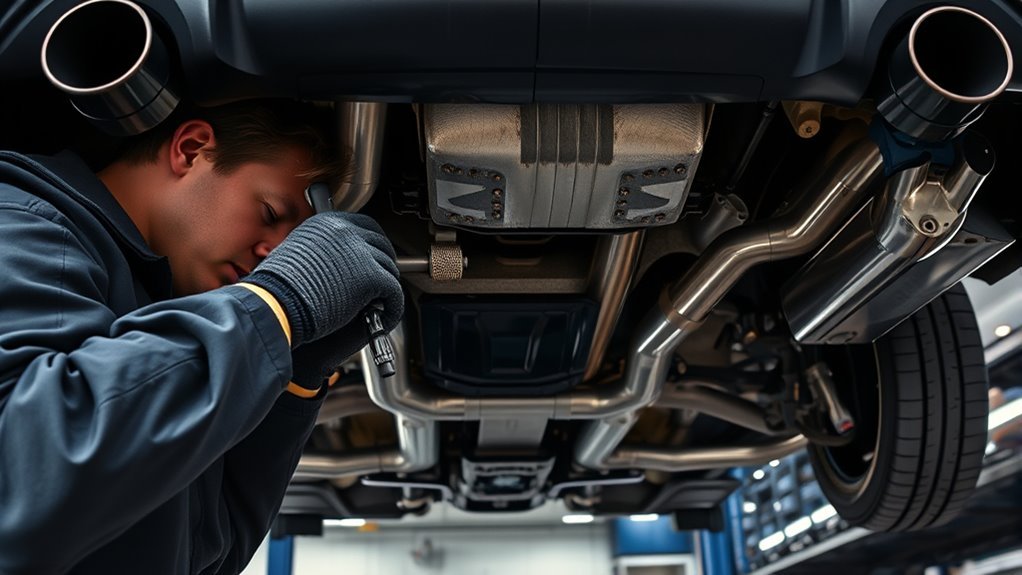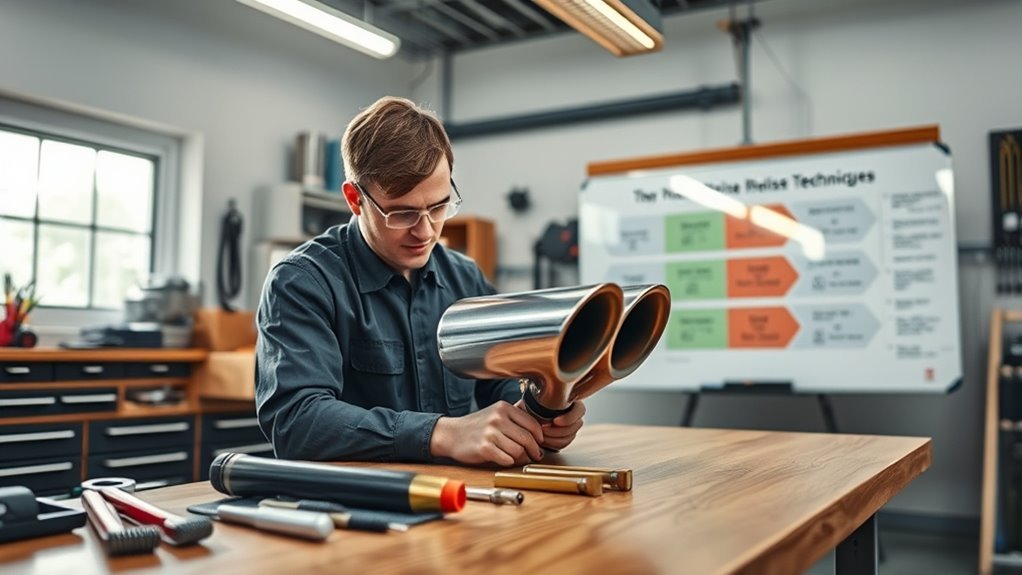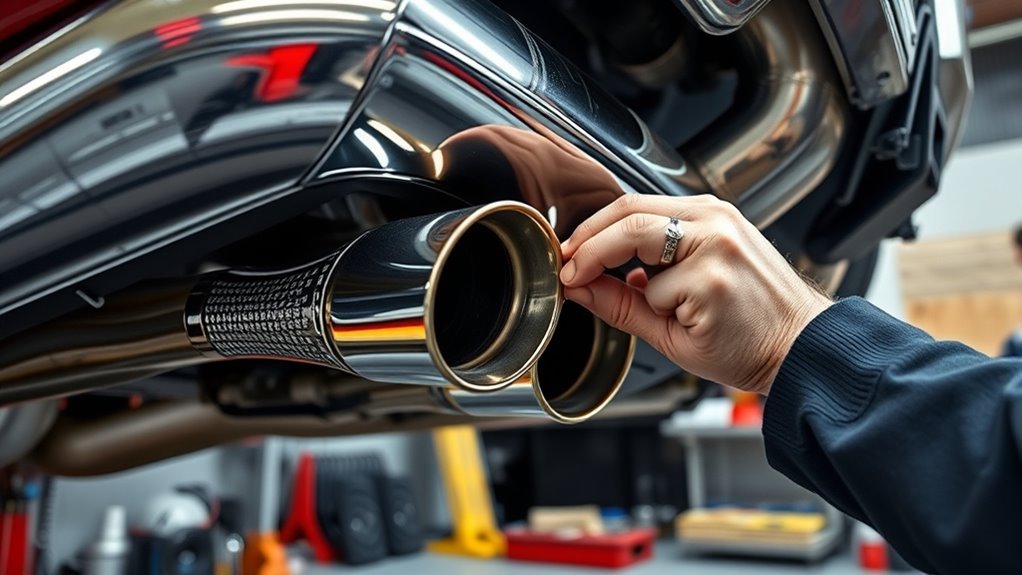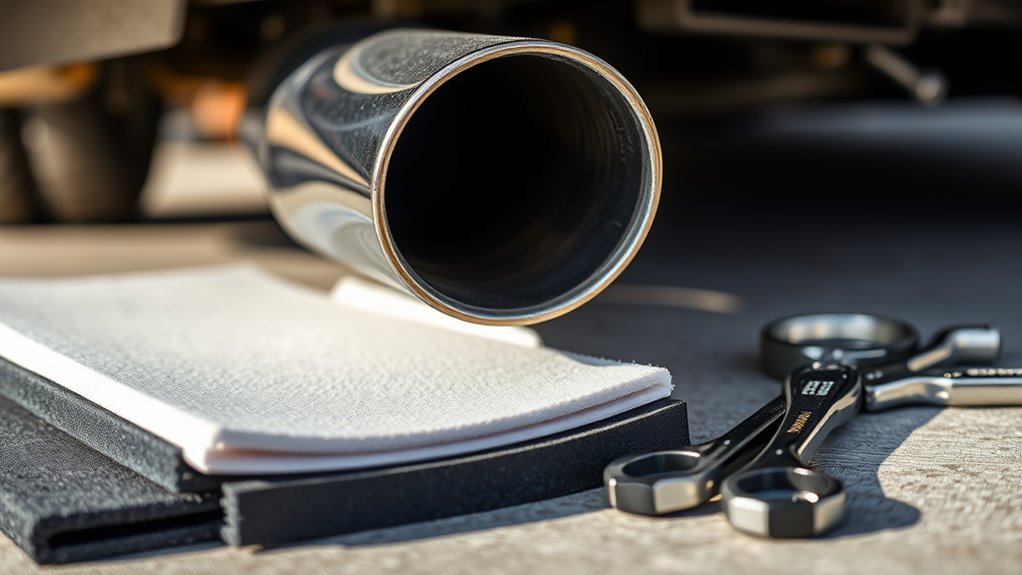To eliminate exhaust drone, first identify the dominant drone frequency by recording sound at different RPMs. Inspect your exhaust system for leaks, rust, or loose components. Upgrade your muffler with chambered or absorptive types to disrupt resonance. Install a resonator precisely tuned to cancel drone frequencies. Apply exhaust wraps for heat management and noise reduction. Adjust your engine tuning and driving habits to avoid drone-prone RPM ranges. For complex cases, professional acoustic analysis can provide custom solutions. Further steps reveal how to optimize each part effectively.
Understanding What Causes Exhaust Drone

Although exhaust drone can be frustrating, understanding its root causes is essential for effective elimination. You need to recognize that exhaust sound is generated by pressure waves traveling through the exhaust system. When these waves reflect and reinforce at specific points, they create a persistent drone at a particular drone frequency. This resonance occurs when the frequency matches the natural frequency of the exhaust components or the cabin space, amplifying the sound. You should note that the drone frequency is influenced by factors such as engine speed, exhaust length, and muffler design. By grasping how these variables interact to produce the exhaust drone, you gain the technical insight necessary to pursue targeted solutions that restore your driving freedom without intrusive noise.
Identifying the Frequency and Source of the Drone

Before you can effectively eliminate exhaust drone, you need to pinpoint its exact frequency and origin within your vehicle’s exhaust system. Start by conducting a detailed frequency analysis using a sound measurement device or smartphone app calibrated for accuracy. Record the drone sound at various engine RPMs to identify consistent frequency peaks. Focus on frequencies typically between 20 and 200 Hz, where drone commonly occurs. Next, isolate sections of the exhaust system—muffler, resonator, pipes—and use targeted sound measurement to detect where the dominant frequencies intensify. This methodical approach lets you locate the precise source, whether it’s resonance in a pipe length or muffler cavity. By accurately identifying the drone’s frequency and source, you’ll gain the freedom to implement targeted solutions confidently and efficiently.
Inspecting Your Exhaust System for Damage or Leaks

Once you’ve identified the drone’s frequency and source, the next step is to thoroughly inspect your exhaust system for any damage or leaks that might amplify or contribute to the noise. Begin by visually examining all accessible components—pipes, joints, clamps, and hangers—for cracks, rust, or holes. Pay close attention to welds and connection points, as these are prone to deterioration. Next, perform a physical check by gently tapping sections to detect loose parts that could vibrate excessively. To pinpoint leaks, use a smoke test or soapy water sprayed on joints while the engine runs; bubbles indicate escaping gases. Addressing these issues guarantees your exhaust system maintains its structural integrity, which is vital for effective noise reduction and preserving your vehicle’s freedom from intrusive exhaust drone.
Adding or Upgrading Mufflers to Reduce Drone
When aiming to reduce exhaust drone, adding or upgrading your muffler can greatly alter sound frequencies and dampen resonance. Different muffler types offer varying levels of sound absorption, critical for targeting drone-specific frequencies. Choosing the right muffler guarantees you reclaim driving freedom without unwanted noise.
| Muffler Type | Sound Absorption Characteristics |
|---|---|
| Chambered | Reflects sound waves, reduces drone |
| Straight-Through | Minimal absorption, louder exhaust tone |
| Turbo | Spiral design, enhances absorption |
| Glass-Pack | Moderate absorption, aggressive tone |
| Absorptive | Packed with fiberglass, superior damping |
Select absorptive or chambered mufflers for effective drone reduction. Confirm proper fit and installation to optimize sound control and preserve exhaust flow.
Installing Resonators to Cancel Out Unwanted Frequencies
To effectively cancel out unwanted frequencies, you’ll need to understand the different types of resonators available, such as chambered, straight-through, and Helmholtz designs. Installation involves precise placement in the exhaust system to target specific drone frequencies without compromising flow. Following a step-by-step process guarantees peak performance and noise reduction.
Resonator Types Overview
Although exhaust drone can be frustrating, installing the right type of resonator can effectively cancel out specific unwanted frequencies. You’ll find resonator designs primarily fall into two categories: Helmholtz and chamber resonators. Helmholtz resonators use a cavity and neck to target precise frequencies, while chamber resonators rely on internal baffling to disrupt sound waves. Selecting appropriate resonator materials—typically stainless steel or aluminized steel—affects durability and sound absorption. Stainless steel offers corrosion resistance and longevity, ideal for harsh conditions, whereas aluminized steel balances cost and performance. Understanding these resonator designs and materials allows you to tailor your exhaust system, ensuring it eliminates drone without compromising flow or sound quality. This precision empowers you to regain driving freedom with a quieter, more comfortable ride.
Installation Process Steps
Before you begin installing resonators to cancel out unwanted frequencies, you need to thoroughly assess your exhaust system’s layout and identify the specific locations where drone occurs. Start by selecting a resonator compatible with your muffler selection to guarantee ideal exhaust tuning. Measure the pipe diameter at the drone-prone zones, then cut the exhaust pipe precisely at these points using a pipe cutter or saw. Deburr the edges to prevent airflow disruption. Slide the resonator into place, aligning it carefully to maintain smooth exhaust flow. Secure the resonator with clamps or weld for a permanent fit. After installation, test drive and listen for drone reduction. Fine-tune placement or resonator size if necessary to achieve maximum freedom from exhaust drone without compromising performance.
Using Exhaust Wraps and Heat Shields to Minimize Noise
You can reduce exhaust drone by applying wraps that retain heat and dampen vibrations along the exhaust pipes. Selecting the right heat shield material—whether aluminum, stainless steel, or composite—also plays a critical role in noise reduction. Proper installation guarantees ideal contact and coverage, maximizing the effectiveness of these components.
Benefits of Exhaust Wraps
When exhaust wraps are applied correctly, they serve to retain heat within the exhaust pipes, which not only improves exhaust gas velocity but also reduces the intensity of sound waves responsible for drone. This precise heat management enhances exhaust performance by maintaining ideal temperatures, allowing your engine to breathe more efficiently while minimizing unwanted noise. By insulating the pipes, wraps limit heat loss and reduce under-hood temperatures, protecting surrounding components.
Key benefits include:
- Improved exhaust gas flow leading to better throttle response
- Reduced sound wave amplitude, directly targeting exhaust drone
- Enhanced thermal protection for both pipes and nearby parts
Using exhaust wraps methodically grants you control over noise and performance, freeing you from the distraction of drone without sacrificing power or reliability.
Types of Heat Shields
Exhaust wraps effectively manage heat retention and sound wave reduction, but combining them with appropriate heat shields can further control exhaust drone. Understanding heat shield materials and heat shield benefits allows you to select the best type for your system, enhancing thermal protection and noise mitigation.
| Heat Shield Type | Key Characteristics |
|---|---|
| Aluminum | Lightweight, reflective, durable |
| Stainless Steel | High-temperature resistance, corrosion-resistant |
| Ceramic Coated | Superior heat insulation, wear-resistant |
| Fiberglass | Flexible, cost-effective, moderate durability |
| Carbon Fiber | Lightweight, high thermal resistance, premium option |
Each material offers specific benefits, so choosing the right heat shield complements exhaust wraps, improving overall efficiency and freedom from exhaust drone.
Installation Tips and Tricks
Although proper material selection is critical, the effectiveness of noise reduction depends heavily on precise installation techniques. When applying exhaust wraps and heat shields, you need to guarantee a tight, secure fit over exhaust materials without gaps or overlaps that reduce performance. Proper surface preparation—cleaning and drying the pipes—is essential to maximize adhesion and durability. Remember to use stainless steel ties to fasten wraps firmly, preventing loosening from vibration.
Key installation tips include:
- Guaranteeing consistent tension when wrapping to avoid noise leaks
- Positioning heat shields to reflect and absorb sound waves efficiently
- Checking for contact points that could cause rattling or wear
Adjusting Engine RPM and Driving Habits to Avoid Drone
Since drone often occurs at specific engine speeds, carefully adjusting your RPM can markedly reduce or eliminate the unwanted noise. Begin by identifying the RPM range where drone is most prominent, then modify your driving techniques to avoid prolonged operation within that range. Engine tuning plays an essential role here; optimizing ignition timing and fuel delivery can shift the drone frequency outside your typical driving spectrum. Practicing smooth acceleration and deceleration helps maintain engine speed outside drone-prone zones. Additionally, using higher gears at lower RPMs reduces exhaust resonance. By combining precise engine tuning with conscious driving habits, you can effectively suppress drone without compromising performance. This methodical approach grants you greater control over your vehicle’s acoustic profile, enhancing your driving freedom and comfort during every journey.
Consulting a Professional for Custom Exhaust Solutions
If adjusting your engine RPM and driving habits doesn’t fully resolve the drone, it’s wise to consult a professional who specializes in custom exhaust solutions. A professional consultation guarantees a tailored approach, addressing the root cause of drone through precise custom exhaust design. Experts analyze your vehicle’s acoustics, pipe diameter, and muffler type to eliminate unwanted frequencies without compromising performance.
During your consultation, expect:
- Detailed acoustic analysis to identify drone frequency
- Custom exhaust design recommendations for ideal sound control
- Installation of specialized components like resonators or Helmholtz chambers

